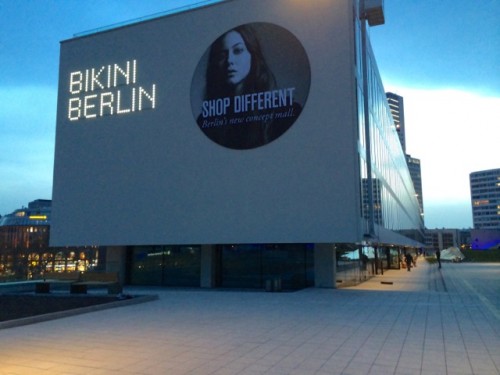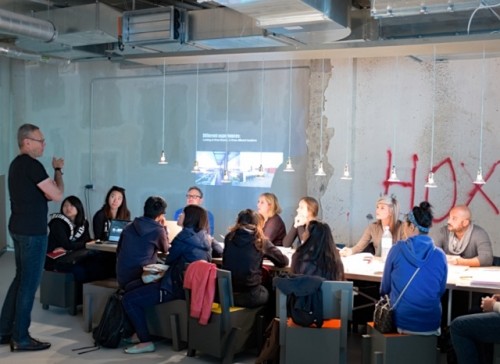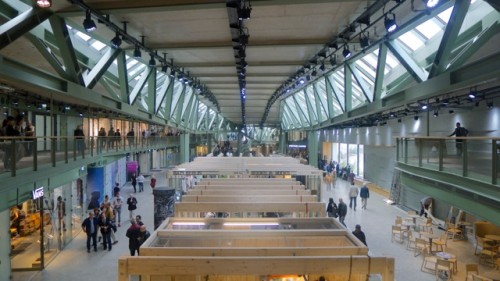Art Center’s pop-up studio in BIKINI BERLIN
Over the past 12 years Art Center has built a rich track record of studio abroad projects in the German capital. What started out as an anarchistic design intervention squatting an abandoned drugstore back in 2003, has evolved into a robust educational program in the thriving urban environment of Berlin, sought after by students, faculty and alumni. The ensuing suite of semester-long transdisciplinary projects was co-created by Nik Hafermaas and David Mocarski, the department chairs of Graphic Design and Environmental Design respectively. Under the labels “Fresh Eyes Berlin” and later “Testlab Berlin,” the two majors plus the Illustration department have hosted more than ten projects combined.
Testlab Berlin projects use art and design strategies to envision how we will live in the future and are often sponsored by brands that are seeking genuinely fresh creative insights derived from first-hand cultural immersion in the multi-cultural laboratory that is Berlin.
Today, Art Center has found a high-visibility space in BIKINI BERLIN*: a new retail urban marketplace, catering to the young and innovative located in the very center of former West Berlin, vis-à-vis Kurfürstendamm and directly adjacent to the Berlin Zoological Garden. BIKINI BERLIN and the recently opened Waldorf Astoria signify a renaissance of Berlin’s City West, marking a transition to an increasingly popular and upscale neighborhood favored by opinion leaders and creative professionals. The newly designed space will serve as the creative hub for Art Center students studying in Berlin. The inaugural project “Pillow to Pillow,” hosted by Environmental Design and taught by Testlab Berlin veteran Rob Ball, kicked off just a few weeks ago.
Creating a nomadic learning environment
Art Center’s study abroad program offers a unique approach on the international experience for students. In a traditional international student exchange, students oftentimes simply relocate from one sheltered classroom setting to another, or what Hafermaas has coined ‘box-to-box.’
As described by Hafermaas, “A ‘studio abroad’ project is designed to deliberately remove the students from any school setting and move them into the atmosphere of a pop-up design office, organized and operated like a professional creative agency, running for a limited time of one semester (14 weeks), and organized by faculty and students. A network of high-caliber members of the local creative industries (communication and design agencies, architects, artists) support the studio as dedicated mentors.”
The most important player in this creative collaboration, however, is the urban environment (Berlin, in this case). The German capital’s thriving cultural and subcultural life provides inspiration and raw material for innovative creative solutions. At the same time, the city is a unique testing ground for scenarios and prototypes. Mocarski explains: “Berlin is the perfect test pad for our students to define and redefine their creative limits. Projects like these, teach them how to be nimble and fresh, with an eye to the future.”
In this studio model, insights are generated through participatory research and prototyping. Making informs strategy, which can lead to genuinely unexpected creative solutions. In past years, students have generated fundamentally new insights for corporate partners like Johnson & Johnson (The Future of Health & Wellness), Sennheiser (The Future of the Retail Experience) and Berlin Partner (The Future of Mobility).
Veterans from past summer programs continue to collaborate with each other on projects beyond the school. “Through their shared experience they become like the friendly version of a SWAT team which could be parachuted into virtually any environment: they land on their feet, set up camp and get to (design) work,” says Hafermaas.
The benefit of a headquarters
The Art Center BIKINI BERLIN studio, equipped with custom-designed “Lida Street” furniture by Product Design alumnus and on-site Managing Director Michael Sans (BS 97 Product), is a very hip space, successfully straddling the line between serving as a raw and flexible creative environment and mirroring its setting in a brand new fashion-minded environment.
This open studio will also serve as a center for European Art Center alumni to connect our school to a vast network of creative leaders in Berlin. BIKINI BERLIN has the potential to become a gathering space supporting creative exchanges, and a venue for hosting design storms coordinated by Art Center’s Partners in Industry group.
Projects are currently in the works for May– July and September– November and the space is open to all Art Center majors for initiatives and projects. But what happens to the space after the conclusion of a project? Video footage promoting Art Center is looped in the storefront where rotating exhibits of student work create an enticing virtual window to the Pasadena main campus.
“For Art Center BIKINI BERLIN to become a permanent satellite institution, deeply anchored in Berlin’s dynamic creative industries, with an opportunity to form a truly global network with more Art Center Satellite studios, potentially located in Asia, South America and in other emerging creative hot beds,” envisions Hafermaas.
Students and alumni are encouraged to connect with Hafermaas or Hannah Huang, director of international and study away programs, for information on how to become involved. Those interested in learning more about the space are invited to contact Michael Sans.
*The name BIKINI BERLIN is derived from the colloquial name Bikini-Haus, coined by the Berlin population in the fifties for the building. Originally designed with an open floorplan above the second floor, the building was structured into an upper and lower portion. The two-segment architecture that is now restored, apparently reminded Berliners of the then-novel and daring swimwear.
For updates: http://www.facebook.com/artcenterberlin











